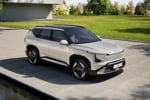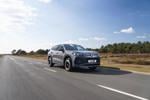The manufacturer stunned visitors to the North American International Auto Show in Detroit with its concept car called AUTOnomy, a project that arguably represents the most radical rethink of car design.
GM has already applied for 24 patents for the fuel cell-powered AUTOnomy. The car uses 'by-wire' technology which allows acceleration, braking, steering and other systems to be controlled electronically rather than mechanically.
The result is a vehicle whose control systems, fuel cells, hydrogen storage and electric motors are contained within a six-inch deep 'skateboard' chassis, leaving the vehicle body free from all traditional design restraints.
And the radical technology showcased in AUTOnomy could become a production reality within 10 years, according to GM.
Wayne Cherry, GM vice-president of design, said: 'People could sit wherever they are comfortable and drivers wouldn't have to sit in the traditional location.
'They could move to the centre of the vehicle or they could move much closer to the front bumper or further back.'
This means that a company car driver heading from the UK to France could transform his car from right-hand drive to left-hand drive simply by changing seats as he crossed the Channel.
And by removing the need for a steering column, pedals and transmission, drive-by-wire technologies free completely a vehicle's architecture, so the skateboard chassis could be used as a platform for a luxury limousine, van or farm vehicle.
AUTOnomy may be a striking two-seat sports car now, but Cherry added: 'Next, we might do a mobility body that allows a wheelchair user to roll right into the driving position, or a 10-seat transit bus.'
Larry Burns, GM vice-president of research and development and planning, said the AUTOnomy concept provides a vision for a hydrogen economy to replace today's global oil economy.
Fuel cells emit nothing but water from the tailpipe and use renewable energy as their power source.
He said: 'With a hydrogen economy we have an opportunity for sustainable economic development which respects the environment and creates the path to non-petroleum and renewable energy sources without constraining economic growth.'
Burns even mooted the idea that drivers could buy a platform over a 20-year period and update or increase the fuel cell stack and change the body style to suit their changing needs. GM concedes that fuel cells, and particularly hydrogen refuelling and storage, still needs significant further development and is looking for fleet involvement to speed its progress.
Chris Borroni-Bird, director of GM's Design and Technology Fusion Group, said: 'Pool fleets and geographically captive fleets that return to the same depot each day will probably be the first application for this technology.'
##AUTOnomy--none--GM vice-president Larry Burns with the AUTOnomy concept at
the Detroit show. (The 'skateboard' is top right)##












Login to comment
Comments
No comments have been made yet.